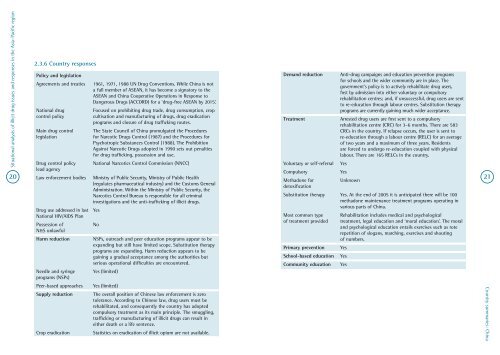Illicit Drug use in the Asia Pacific Region - Burnet Institute
Illicit Drug use in the Asia Pacific Region - Burnet Institute
Illicit Drug use in the Asia Pacific Region - Burnet Institute
You also want an ePaper? Increase the reach of your titles
YUMPU automatically turns print PDFs into web optimized ePapers that Google loves.
Situational analysis of illicit drug issues and responses <strong>in</strong> <strong>the</strong> <strong>Asia</strong>–<strong>Pacific</strong> region<br />
20<br />
2 .3 .6 Country responses<br />
Policy and legislation<br />
Agreements and treaties 1961, 1971, 1988 UN <strong>Drug</strong> Conventions . While Ch<strong>in</strong>a is not<br />
a full member of ASEAN, it has become a signatory to <strong>the</strong><br />
ASEAN and Ch<strong>in</strong>a Cooperative Operations <strong>in</strong> Response to<br />
Dangerous <strong>Drug</strong>s (ACCORD) for a ‘drug-free ASEAN by 2015’ .<br />
National drug<br />
control policy<br />
Ma<strong>in</strong> drug control<br />
legislation<br />
<strong>Drug</strong> control policy<br />
lead agency<br />
Foc<strong>use</strong>d on prohibit<strong>in</strong>g drug trade, drug consumption, crop<br />
cultivation and manufactur<strong>in</strong>g of drugs, drug eradication<br />
programs and closure of drug traffick<strong>in</strong>g routes .<br />
The State Council of Ch<strong>in</strong>a promulgated <strong>the</strong> Procedures<br />
for Narcotic <strong>Drug</strong>s Control (1987) and <strong>the</strong> Procedures for<br />
Psychotropic Substances Control (1988) . The Prohibition<br />
Aga<strong>in</strong>st Narcotic <strong>Drug</strong>s adopted <strong>in</strong> 1990 sets out penalties<br />
for drug traffick<strong>in</strong>g, possession and <strong>use</strong> .<br />
National Narcotics Control Commission (NNCC)<br />
Law enforcement bodies M<strong>in</strong>istry of Public Security, M<strong>in</strong>istry of Public Health<br />
(regulates pharmaceutical <strong>in</strong>dustry) and <strong>the</strong> Customs General<br />
Adm<strong>in</strong>istration . With<strong>in</strong> <strong>the</strong> M<strong>in</strong>istry of Public Security, <strong>the</strong><br />
Narcotics Control Bureau is responsible for all crim<strong>in</strong>al<br />
<strong>in</strong>vestigations and <strong>the</strong> anti-traffick<strong>in</strong>g of illicit drugs .<br />
<strong>Drug</strong> <strong>use</strong> addressed <strong>in</strong> last Yes<br />
National HIV/AIDS Plan<br />
Possession of<br />
No<br />
N&S unlawful<br />
Harm reduction NSPs, outreach and peer education programs appear to be<br />
expand<strong>in</strong>g but still have limited scope . Substitution <strong>the</strong>rapy<br />
programs are expand<strong>in</strong>g . Harm reduction appears to be<br />
ga<strong>in</strong><strong>in</strong>g a gradual acceptance among <strong>the</strong> authorities but<br />
serious operational difficulties are encountered .<br />
Needle and syr<strong>in</strong>ge Yes (limited)<br />
programs (NSPs)<br />
Peer-based approaches Yes (limited)<br />
Supply reduction The overall position of Ch<strong>in</strong>ese law enforcement is zero<br />
tolerance . Accord<strong>in</strong>g to Ch<strong>in</strong>ese law, drug <strong>use</strong>rs must be<br />
rehabilitated, and consequently <strong>the</strong> country has adopted<br />
compulsory treatment as its ma<strong>in</strong> pr<strong>in</strong>ciple . The smuggl<strong>in</strong>g,<br />
traffick<strong>in</strong>g or manufactur<strong>in</strong>g of illicit drugs can result <strong>in</strong><br />
ei<strong>the</strong>r death or a life sentence .<br />
Crop eradication Statistics on eradication of illicit opium are not available .<br />
Demand reduction Anti-drug campaigns and education prevention programs<br />
for schools and <strong>the</strong> wider community are <strong>in</strong> place . The<br />
government’s policy is to actively rehabilitate drug <strong>use</strong>rs,<br />
first by admission <strong>in</strong>to ei<strong>the</strong>r voluntary or compulsory<br />
rehabilitation centres; and, if unsuccessful, drug <strong>use</strong>rs are sent<br />
to re-education through labour centres . Substitution <strong>the</strong>rapy<br />
programs are currently ga<strong>in</strong><strong>in</strong>g much wider acceptance .<br />
Treatment Arrested drug <strong>use</strong>rs are first sent to a compulsory<br />
rehabilitation centre (CRC) for 3–6 months . There are 583<br />
CRCs <strong>in</strong> <strong>the</strong> country . If relapse occurs, <strong>the</strong> <strong>use</strong>r is sent to<br />
re-education through a labour centre (RELC) for an average<br />
of two years and a maximum of three years . Residents<br />
are forced to undergo re-education coupled with physical<br />
labour . There are 165 RELCs <strong>in</strong> <strong>the</strong> country .<br />
Voluntary or self-referral Yes<br />
Compulsory Yes<br />
Methadone for<br />
Unknown<br />
detoxification<br />
Substitution <strong>the</strong>rapy Yes . At <strong>the</strong> end of 2005 it is anticipated <strong>the</strong>re will be 100<br />
methadone ma<strong>in</strong>tenance treatment programs operat<strong>in</strong>g <strong>in</strong><br />
various parts of Ch<strong>in</strong>a .<br />
Most common type<br />
of treatment provided<br />
Primary prevention Yes<br />
School-based education Yes<br />
Community education Yes<br />
Rehabilitation <strong>in</strong>cludes medical and psychological<br />
treatment, legal education and ‘moral education’ . The moral<br />
and psychological education entails exercises such as rote<br />
repetition of slogans, march<strong>in</strong>g, exercises and shout<strong>in</strong>g<br />
of numbers .<br />
21<br />
Country summaries: Ch<strong>in</strong>a









